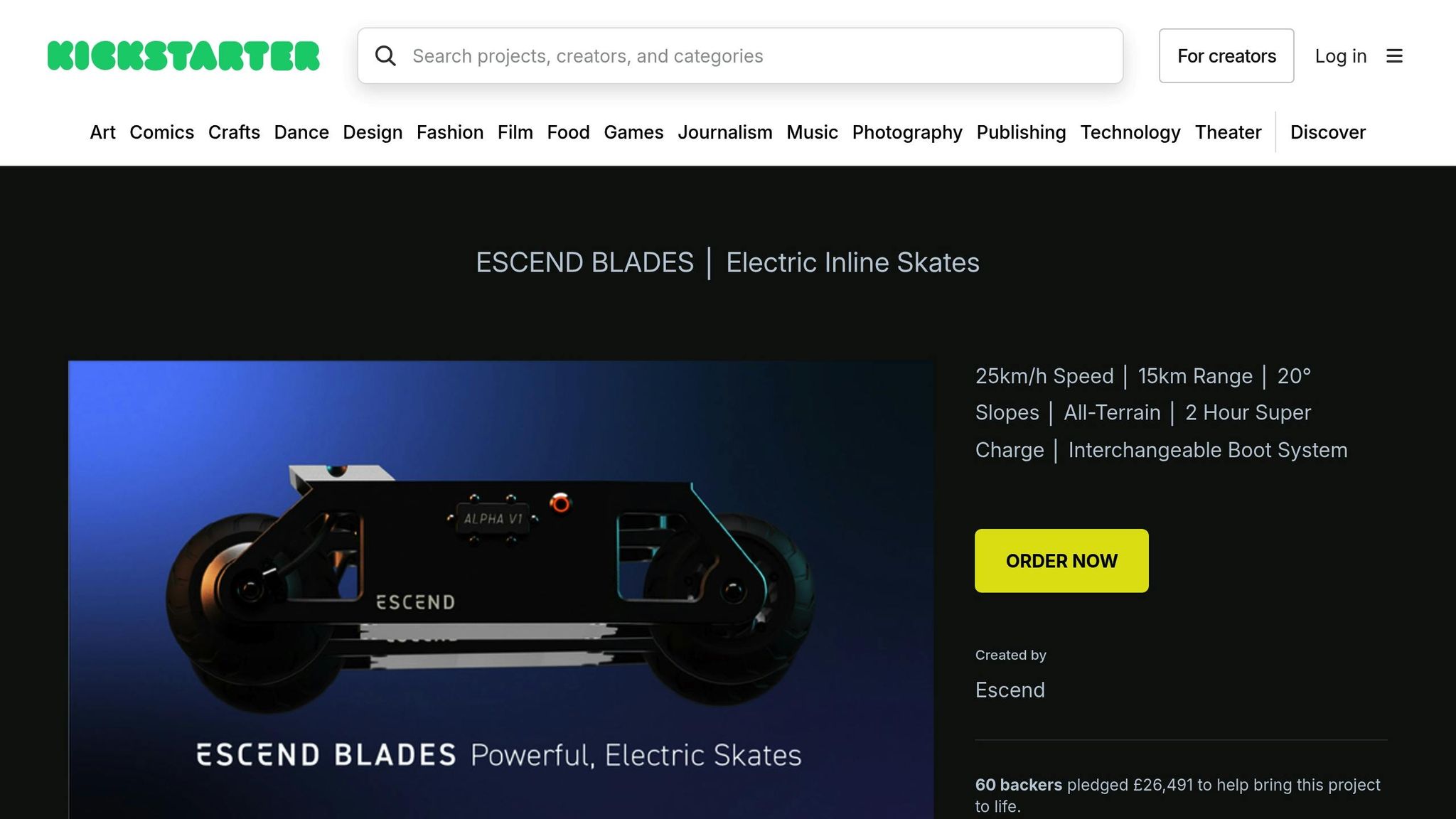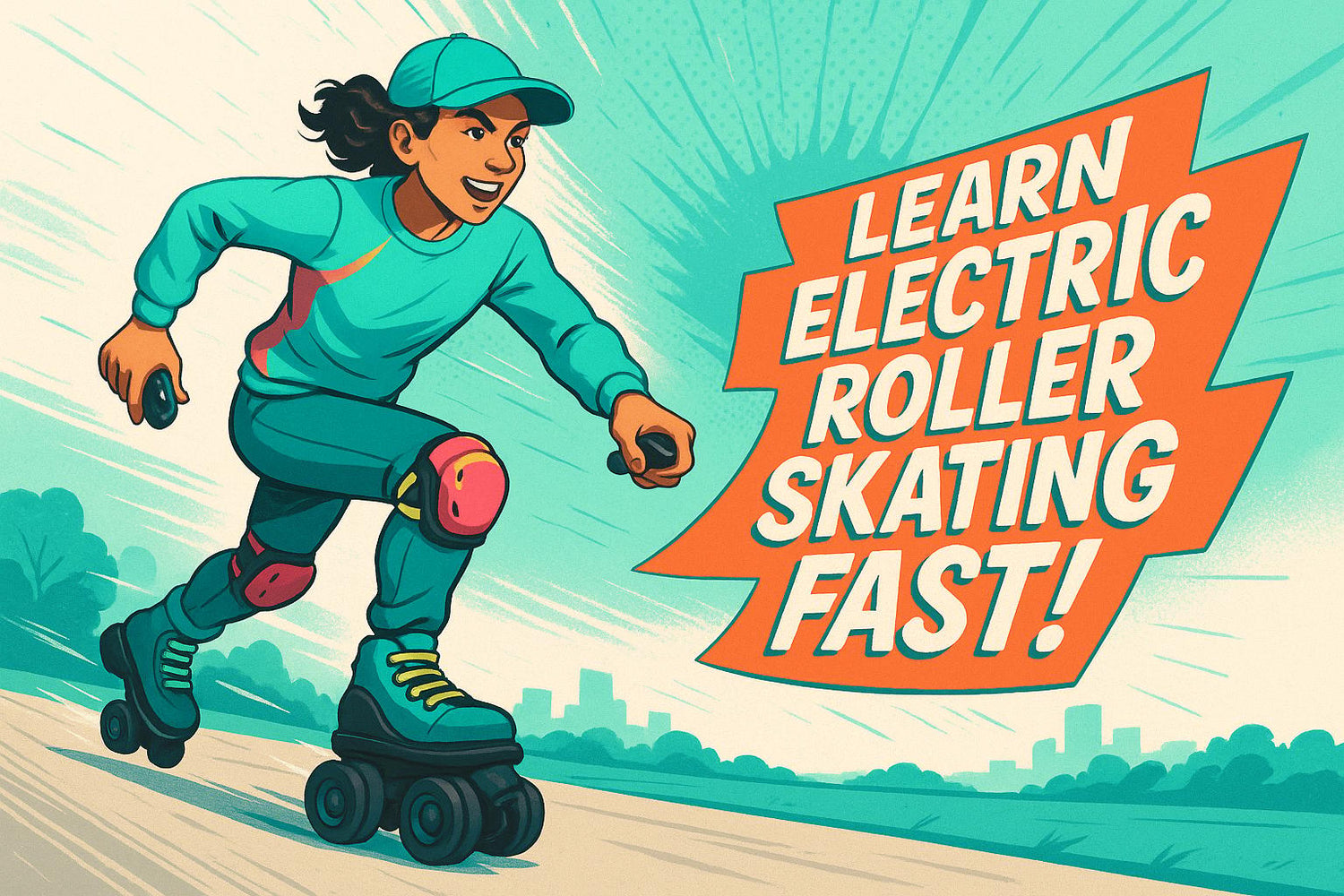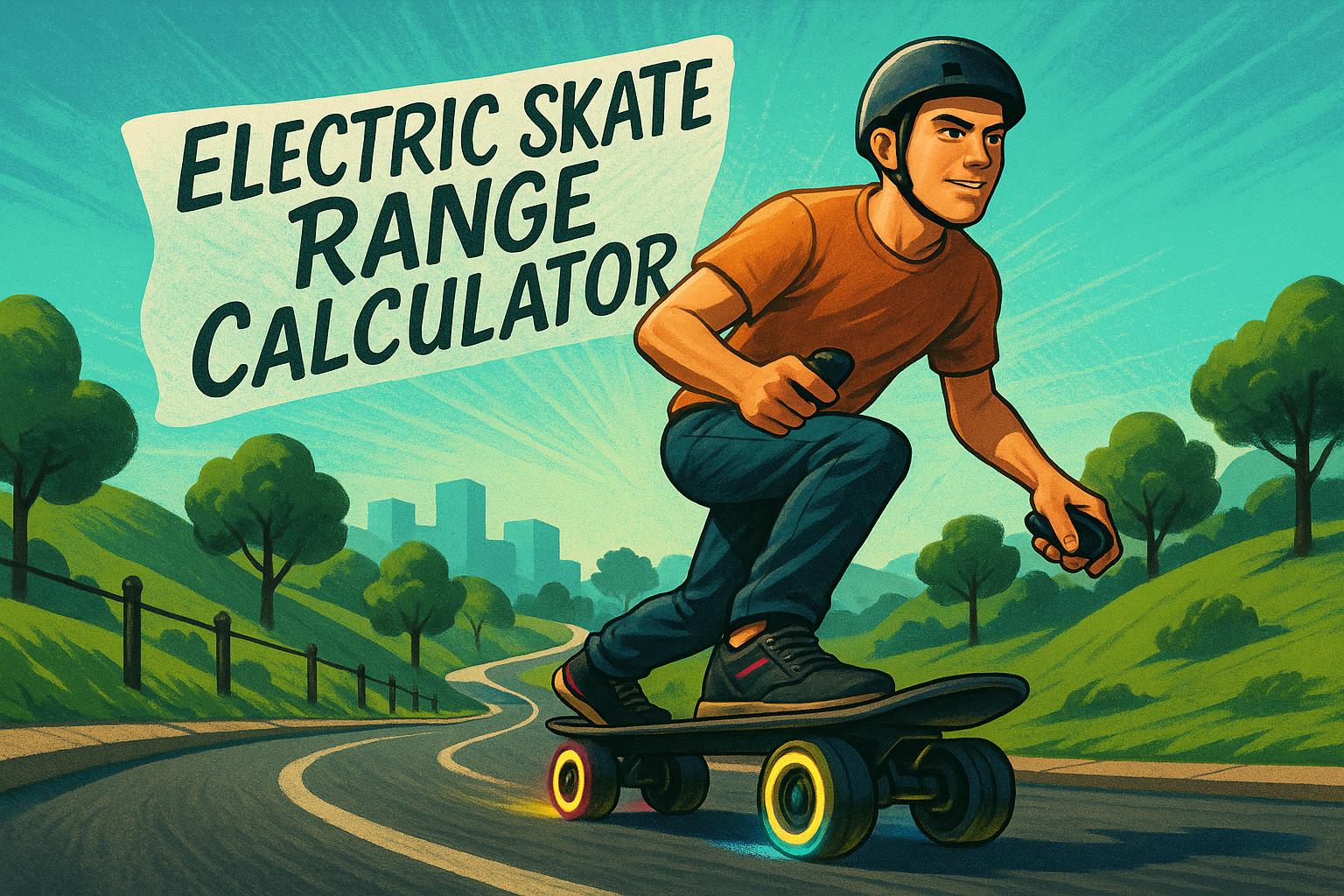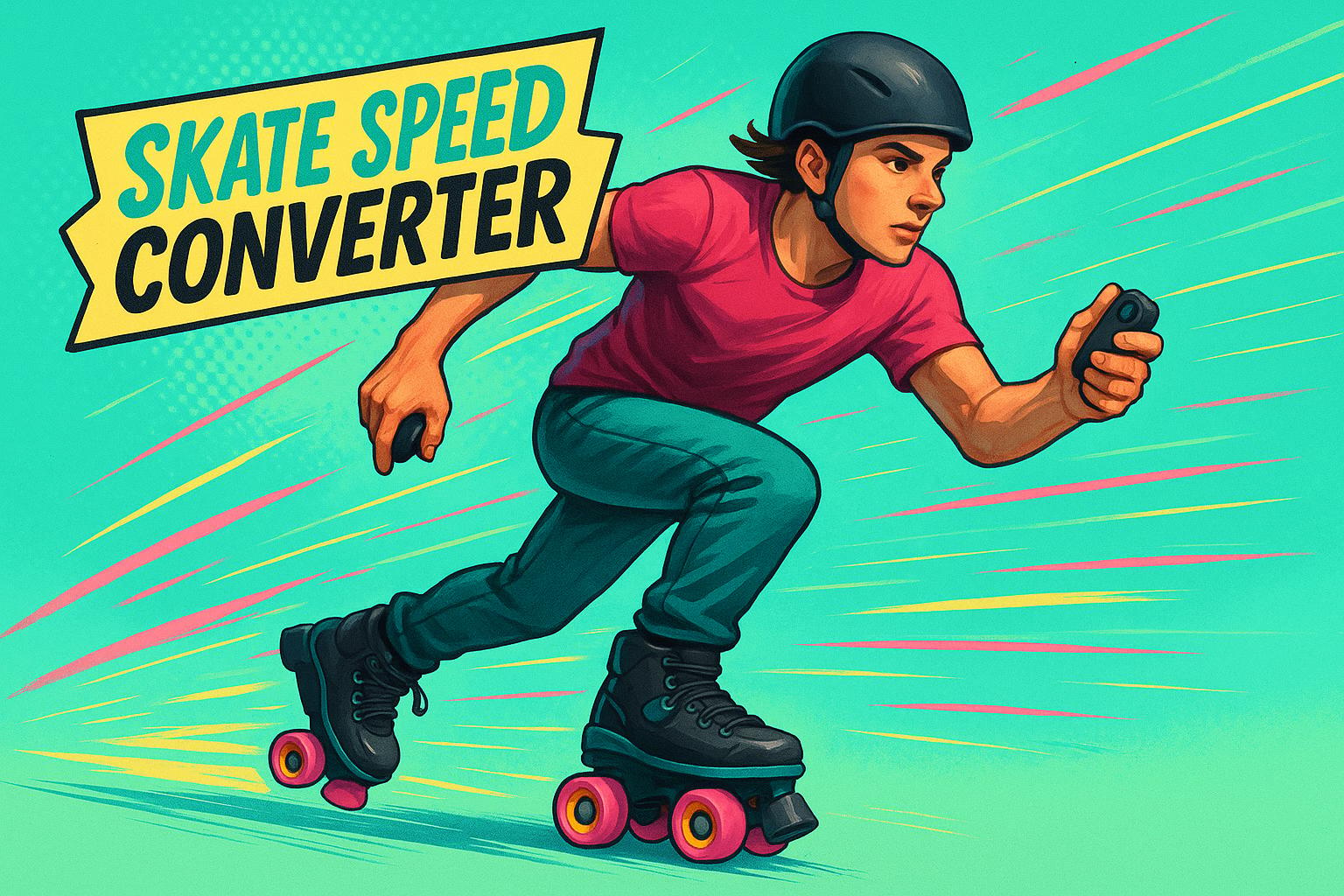Electric roller skating can go from intimidating to enjoyable in just a week with the right plan. Here's how you can master it:
- Start with the Basics: Focus on balance, posture, and slow gliding before increasing speed.
- Gear Up Properly: Invest in beginner-friendly electric skates like Wheelfeet ($599.00) and essential safety gear (helmet, pads, wrist guards).
- Follow a 7-Day Plan: Dedicate 20–30 minutes daily to build skills step-by-step - balance, speed control, turning, and stopping.
- Practice Safely: Use flat, smooth surfaces and avoid busy or uneven areas until you're more confident.
- Maintain Your Equipment: Regularly check skates, wheels, and brakes to ensure safety and performance.
How To Electric Skate (Escend Blades)

Picking the Right Electric Roller Skates and Gear
Choosing the right gear from the beginning can make a huge difference in how quickly and safely you pick up electric roller skating. High-quality equipment not only enhances your experience but also helps you progress faster. Look for gear that fits your budget while supporting your learning journey.
Beginner-Friendly Electric Roller Skates
For those just starting out, Wheelfeet electric roller skates are a solid choice. Currently priced at $599.00 (down from $699.00), these skates are designed with features that cater to beginners. Adjustable speed settings allow you to start slow and increase your pace as you gain confidence. Plus, the regenerative braking system ensures smooth and controlled stops, which is essential for new riders.
These skates accommodate US sizes 6–13 (EU 38–47) and feature a lightweight, compact design that improves control and reduces fatigue - perfect for learning the ropes of electric roller skating.
Essential Safety Gear
Safety gear is non-negotiable when it comes to electric roller skating. It not only protects you from injuries but also gives you the confidence to practice and improve. Here’s what you’ll need:
- Certified Helmet: Look for helmets with ASTM, CPSC, or EN1078 certifications. Prices typically range from $34.79 to $72.99.
- Wrist Guards: These protect your hands during falls and cost between $24.97 and $49.97.
- Knee Pads and Elbow Pads: Knee pads are priced from $19.97 to $54.97, while elbow pads range from $19.97 to $74.97.
- Protection Packs: Bundled sets that include wrist guards, knee pads, and elbow pads are often more cost-effective, with prices between $47.97 and $59.97.
Investing in high-quality protective gear ensures you can practice confidently while minimizing the risk of injury.
Budgeting for Safety and Performance
A well-thought-out budget can help you get the best equipment without overspending. Here’s a suggested breakdown for your initial setup:
| Item Category | Price Range | Budget Priority |
|---|---|---|
| Electric Roller Skates | $599.00 (Wheelfeet) | High – 70% |
| Protection Pack (3-piece) | $47.97–$59.97 | High – 15% |
| Certified Helmet | $34.79–$72.99 | High – 15% |
| Total Investment | $681.76–$731.96 | Complete setup |
Learning Basic Skills and Balance
If you want to improve quickly with electric roller skating, getting the basics down is key. These core skills - like maintaining proper posture, controlling your movements, and mastering turns and stops - are the building blocks for your progress. Once you have these nailed, you'll feel more confident and ready to take on advanced techniques.
Getting Your Posture and Balance Right
Your stance is the foundation of everything you’ll do on electric roller skates. To start, place your feet shoulder-width apart and bend your knees slightly. This creates a steady base, giving you better control even when the skates are in motion.
Engage your core muscles and lean forward just a bit - around 10-15 degrees. This slight forward angle helps balance out the natural pull to fall backward when you accelerate. Let your arms hang loosely at your sides, ready to assist with balance whenever needed.
Practice this stance while stationary until it feels second nature. Your weight should be distributed evenly across both feet, with a bit more pressure on the balls of your feet rather than your heels. This compact, balanced posture is your go-to for maintaining control and responsiveness. Once you’re comfortable, you’re ready to move on to controlled motion.
Starting with Controlled Movement
For your first rides, stick to smooth, flat surfaces like an empty parking lot or a tennis court. Avoid places with cracks, debris, or slopes until you’ve mastered the basics.
Set your Wheelfeet remote to the lowest speed setting - around 2-3 mph. This walking-speed pace is perfect for beginners. Hold the remote in your dominant hand and practice accelerating by gently pressing the forward button.
Focus on gliding, not walking. Many beginners instinctively try to step while the skates are moving, which throws off balance. Instead, keep your feet parallel and let the motors handle the motion. Use your legs to absorb small bumps or changes in the surface.
Practice shifting your weight between your feet as you glide. This helps you maintain stability and prepares you for turning. Spend at least 15-20 minutes working on straight-line gliding to build muscle memory and confidence before moving on to more advanced maneuvers.
How to Turn and Stop
Once you’ve got the hang of balancing and gliding, it’s time to learn how to turn and stop effectively. The easiest way to turn is by shifting your weight. To turn right, lean slightly onto your right foot while keeping both skates on the ground. For a left turn, shift your weight to your left foot. Start with wide, gentle turns, drawing large arcs on the ground. This gives you time to adjust your balance and get a feel for how the skates respond.
When it comes to stopping, use the regenerative braking system for a smooth slowdown. Ease off the forward button gradually to let the skates slow down naturally. This method is more controlled and helps you stay balanced.
For more control, learn the T-stop technique. Lift your back foot slightly and drag the side of that skate behind you, forming a "T" shape with your feet. Practice this at low speeds to get comfortable with it.
In emergencies, lift both feet slightly and let the skates coast to a stop. Avoid stepping off moving skates, as it can easily lead to a fall.
A great way to practice both turning and stopping is by skating in figure-eight patterns. Start with large loops and gradually make them smaller as your control improves. This exercise helps you transition smoothly between movements and builds confidence for more advanced skills.
sbb-itb-bf837b9
7-Day Learning Plan
This week-long plan is designed to help you build skills step-by-step, starting with the basics and progressing to more advanced techniques. By dedicating just 20 to 30 minutes a day, you can develop muscle memory, improve your balance, and gain confidence - all while keeping fatigue and injury risks low.
Day 1-2: Balance and Slow Gliding
Start your first two days by focusing on balance. Stand on your skates with your knees slightly bent and your weight evenly distributed. Once you feel steady, try balancing on one leg for 10–15 seconds, then switch to the other leg. This simple exercise strengthens your core and improves your stability, which is crucial for handling different surfaces.
After working on stationary balance, move into slow gliding. Keep your feet parallel and let the skates glide naturally without stepping. Concentrate on smooth, steady movement, and take breaks if you feel wobbly. Wrap up each session with weight-shifting exercises to prepare for turning techniques later in the week.
Day 3-4: Speed Control and Stopping
With balance and slow gliding under control, it’s time to practice managing your speed. Begin each session with a few minutes of straight-line gliding to warm up, then work on gradually increasing and decreasing your pace. Use gentle motions to accelerate and decelerate until the transitions feel smooth.
Next, focus on the T-stop technique - a key method for controlled stopping. While gliding at a moderate speed, lift your back foot slightly and drag the edge of your skate to slow down. Practice this motion repeatedly, aiming for fluidity rather than abrupt stops. You can also try stop-and-go drills: accelerate briefly, then stop. Repeating this pattern will help you feel more confident in handling speed changes.
Day 5-7: Turning, Stopping, and Higher Speeds
By the final three days, it’s time to combine everything you’ve learned. Start practicing turns to improve your overall control. Try exercises like “Bubbles,” where you skate in large circular patterns. As you gain confidence, make the circles smaller to refine your directional changes. Figure-eight patterns are another great option - they’ll help you transition smoothly between left and right turns, preparing you for real-world situations.
As your skills improve, gradually increase your cruising speed while staying mindful of your balance and stopping techniques. Challenge yourself by setting a “Skill of the Week” goal. For example, practice gliding forward, executing a wide turn, and finishing with a T-stop. Alternate directions to improve agility and decision-making. By the end of the week, you’ll have a solid foundation and a noticeable boost in confidence.
Safety Tips and Building Confidence
Mastering electric roller skating is all about finding the sweet spot between challenging yourself and staying safe. By combining solid safety habits with confidence-building strategies, you can make the learning process smoother and avoid unnecessary setbacks.
Staying Safe During Practice
First things first - protective gear is non-negotiable. Make it a habit to wear a helmet, knee pads, elbow pads, and wrist guards every time you skate. Skipping gear might seem tempting, especially during practice, but accidents often happen when you least expect them.
Before hitting the pavement, give your skates a quick once-over. Check the wheels to ensure they spin freely, test the brakes, and make sure the battery is charged above 20%. Look for any visible damage on the deck or bindings - this helps prevent sudden power loss or mechanical failures while you’re skating.
Know the rules of the road. Many cities have specific regulations for electric skates. Some areas may ban them from sidewalks or restrict their use in bike lanes. A quick check with your local parks department or city website can save you from fines or other headaches.
When choosing where to practice, start in safe, quiet spaces. Empty parking lots, smooth residential streets, or private areas are ideal for beginners. Avoid busy sidewalks, steep inclines, or rough surfaces until you’ve built up your control. If you’re ready to practice in public parks, look for paved paths and double-check for any posted restrictions.
Once your physical safety measures are second nature, it’s time to focus on building mental resilience.
Mental Tips for Building Confidence
Celebrate every small win. Whether it’s gliding 50 feet without wobbling or mastering a smooth stop, these achievements matter. Keep a simple log of your progress - tracking things like balance time, stopping distance, or how smoothly you turn can help you see just how far you’ve come.
Between practice sessions, try visualization techniques. Spend a few minutes picturing yourself executing smooth turns or controlled stops. Imagine the balance, the flow, and the control. This mental rehearsal helps your brain create the pathways needed for physical performance.
When tackling challenging skills, break them into smaller steps. Use positive self-talk to keep tension at bay - remind yourself, “I’m improving with every attempt.” Progress isn’t always a straight line, and some days will feel tougher than others. But here’s the thing: nervous thoughts can create muscle tension, which makes smooth movement harder. A calm, encouraging mindset can make all the difference.
Keeping Your Equipment in Good Shape
Taking care of your skates is just as important as taking care of yourself. Regular maintenance not only keeps you safe but also boosts your confidence on the road.
After each session, charge your skates. Lithium batteries do best when kept between 20% and 80% charge for daily use, but they should be fully charged occasionally to maintain their capacity. Store your skates in a cool, dry spot - extreme temperatures can harm battery life and performance.
Check your wheels weekly. Wiggle each one to ensure it’s tight - loose wheels can cause instability, especially at higher speeds. If you hear rattling or notice uneven wear, inspect the bearings and axles. Most skates use standard skateboard tools for adjustments, but always refer to your manual for specifics.
Keep your skates clean by wiping the deck and bindings with a damp cloth, but avoid getting water near the electrical components. Clear out debris from the wheel wells and ensure the braking mechanism is unobstructed.
Finally, don’t forget about your protective gear. Inspect your helmet, pads, and straps regularly. Over time, helmet straps can stretch, and padding can compress, reducing their effectiveness. Replace any gear that’s cracked, worn, or no longer fits snugly. Knowing your gear is in top shape gives you the confidence to push yourself during practice.
Conclusion: Start Your Learning Journey
Learning to ride electric roller skates doesn’t have to take long when you follow a thoughtful approach. With the right plan, you can build solid skills in just a week while keeping safety a priority.
Start by choosing beginner-friendly equipment and make sure you’re fully geared up with essentials like a helmet, knee pads, elbow pads, and wrist guards. These aren’t just accessories - they’re key to avoiding injuries that could slow you down.
Before you think about speed, focus on balance and mastering basic movements. Perfecting your posture, practicing slow gliding, and building muscle memory are the building blocks of success. A structured 7-day plan helps you stay on track, starting with balance and simple gliding in the first couple of days, and working up to confidently managing higher speeds by the end of the week. Once your physical skills are solid, you’ll be ready to develop the mental focus needed for smooth, confident skating.
Mental preparation plays a big role, too. Celebrate every small victory, use visualization to picture yourself nailing each move, and break down complex techniques into easier steps. These strategies keep you motivated and help you improve steadily.
Regular maintenance of your skates ensures both safety and reliability, letting you concentrate fully on building your skills.
Wheelfeet Electric Roller Skates are a dependable choice for beginners and beyond. With speeds up to 15 mph, a 9-mile range, and a regenerative braking system, they’re designed to support your journey. Adjustable speed settings let you learn at your own pace, and their lightweight build makes them easier to handle as you practice.
Your weeklong journey starts with that first glide. Take it step by step, stick to your practice schedule, and trust the process. By the end of the week, you’ll be cruising smoothly and confidently on your electric skates, ready to enjoy the ride.
FAQs
What features should I consider when choosing electric roller skates for beginners?
When picking electric roller skates for beginners, focus on features that enhance safety and ease of use. Adjustable speed settings are a must, allowing you to start slow and gradually increase speed as your skills improve. A maximum speed of 10–15 mph is a good range for those just starting out. Another important feature is regenerative braking, which ensures smoother stops and gives you better control. Additionally, choose skates with a sturdy build and a comfortable fit to help maintain balance and stability. These elements can make the learning process safer and more enjoyable, helping you gain confidence with every ride.
How can I get over the fear of falling while learning to roller skate?
Overcoming the fear of falling begins with preparation and a bit of practice. Start by wearing protective gear - a helmet, knee pads, elbow pads, and wrist guards. These not only help you feel safer but also reduce the risk of injuries if you do take a tumble. To ease into the experience, try practicing intentional falls on soft surfaces like grass or a carpeted area. This helps you get used to the sensation and builds your confidence.
Falling is just part of the process when you're learning something new. Take it slow, focus on improving your balance, and work on small, manageable steps to grow your comfort level. If you can, join a beginner class or practice with a friend. Having support and encouragement makes a big difference. With patience and persistence, you'll find yourself feeling more at ease on your skates!
What are the most common mistakes beginners make when learning electric roller skating, and how can they avoid them?
Beginners often stumble into a few common pitfalls when learning to electric roller skate. One big one? Skipping protective gear. Helmets, knee pads, and wrist guards aren’t just accessories - they’re your first line of defense against injuries from inevitable falls. Gear up every time to stay safe.
Another frequent mistake is rushing to skate at high speeds before mastering the basics. Add to that poor posture, and you’ve got a recipe for instability and spills. Instead, start slow. Keep your knees slightly bent, your weight evenly distributed, and focus on maintaining control. These small adjustments make a huge difference in balance and confidence.
Lastly, practicing in busy or unsafe areas can make learning way more stressful than it needs to be. Opt for a smooth, open space with minimal obstacles. A calm environment lets you focus on building skills without unnecessary distractions. Prioritize safety, take your time, and practice consistently to make the learning process both fun and rewarding!




Leave a comment
All comments are moderated before being published.
This site is protected by hCaptcha and the hCaptcha Privacy Policy and Terms of Service apply.